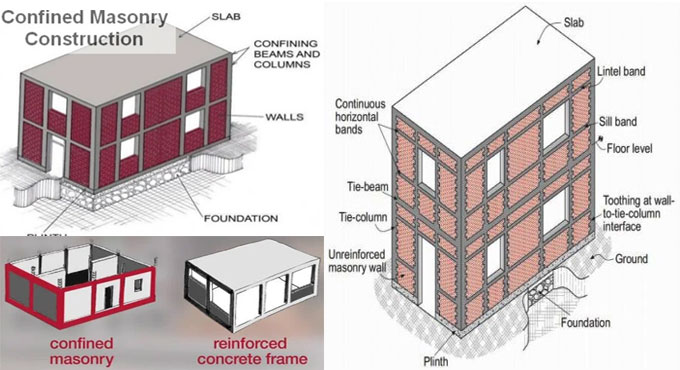
Earthquake-Resistant Confined Masonry ? Components, Difference, and Advantages
Confined masonry development is a blend of two masonry, which comprises masonry walls (clay brick or solid block units) and even and vertical RC restricting members based on each of the four sides of a masonry wall panel.
Vertical members, for example, tie-columns or reasonable columns go about as columns in RC outline development with the exception that they are of little cross-section. Level components, for example, rafters take after beams in RC outline development.
In this article, we will talk about the auxiliary parts, contrasts, favorable circumstances, and utilization of confined masonry.
Auxiliary Component of Confined Masonry
1. Masonry Walls: Masonry walls move the heaps of the upper chunks to the establishment effectively. The walls in the confined masonry go about as the propping panels, which oppose level seismic tremor powers.
The walls of this kind of masonry are confined by solid rafters and bind columns to guarantee good tremor execution.
2. Binding Elements: The binding components give limitation to masonry walls and shield them from complete breaking down, even in case of a significant quake. These components oppose gravity stacks and have a basic job in guaranteeing the vertical soundness of a structure in a seismic tremor.
3. Pieces (Floor and Roof): The piece of the confined masonry helps in transmitting both gravity and parallel burdens to the walls. In a seismic tremor, the piece carries on like level beams and is called stomachs.
4. Plinth Beam or Band: The plinth band moves the heap starting from the walls to the establishment by shielding the ground floor walls from extreme settlement in delicate soil conditions.
5. Establishment: The establishment demonstrations ordinarily as in regular masonry by moving the heap from the structure to the ground.
Elements Influencing the Seismic Resistance of Confined Masonry - The elements or segments of the confined masonry which impact the seismic opposition are point by point underneath:
1. Wall Density: General examinations have demonstrated that the structure having more wall thickness endures less harm than the ones having less wall thickness. The wall thickness is determined as the transverse zone of walls every important way isolated by the all out floor zone of the structure.
The above explanation is the reason every nation codes give the base wall thickness prerequisite for various celebrated structures, in view of their customary method of wall development.
A study done during the Llolleo seismic tremor in 1985 demonstrated that the harm that happened to the confined masonry with 1.15% wall thickness was less contrasted with the masonry working with 0.5% wall thickness.
2. Masonry Units and Mortar: The tests have indicated that the sidelong burden opposition of confined masonry walls firmly relies upon the quality of the masonry units and the mortar utilized.
The walls assembled utilizing low-quality bricks or ungrouted empty block units had the least quality, while the ones made utilizing grouted or strong units had the most noteworthy favorable position.
3. Tie-Columns: The arrangement of firmly dispersed transverse fortification (ties) at the top and base parts of the bargains brings about improved wall strength and flexibility in the post-splitting stage.
Tie-columns essentially impact the malleability and soundness of split confined masonry walls.
4. Level Wall Reinforcement: The arrangement of level wall support in the structure with multiple accounts beneficially affects wall flexibility. Walls with flat support indicated a more uniform conveyance of slanted shear breaks than the unreinforced examples.
The even support is given as a couple of wires laid in the mortar bed joints.
Favorable circumstances of Confined Masonry
a. It improves the solidness and respectability of masonry walls for in-plane and out-of-plane seismic tremor loads.
b. It improves the quality (opposition) of masonry walls under sidelong quake loads.
c. It diminishes the fragility of masonry walls under seismic tremor loads and subsequently improves their quake execution.
Utilizations of Confined Masonry
The act of confined masonry development began in Chile during the 1930s after the 1928 Talca quake (Magnitude 8.0) that influenced a critical number of unreinforced masonry structures. Therefore, the 1939 quake (Magnitude 7.8) that struck the mid-southern district of the nation uncovered the amazing presentation of confined masonry structures.
The confined masonry development was presented in Mexico City, Mexico, during the 1940s to control the wall breaking brought about by huge differential settlements under the delicate soil conditions, which later got celebrated for its magnificent quake execution.
The utilization of confined masonry in Colombia dates from the 1930s, and it is right now broadly utilized for lodging development, from single-story homes to five-story high rises.


